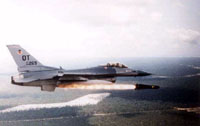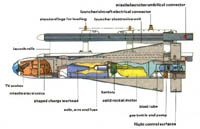AIM-120 AMRAAM
 The AIM-120 AMRAAM (Advanced Medium Range Air to Air Missile) is a new generation air-to-air missile. It has an all-weather, beyond-visual-range capability and is scheduled to be operational beyond 2000. The missile incorporates an active radar with an inertial reference unit and micro-computer system, which makes the missile less dependent upon the fire-control system of the aircraft. Once the missile closes on a target, its active radar guides it to intercept. This enables the pilot to aim and fire several missiles simultaneously at multiple targets. The pilot may then perform evasive maneuvers while the missiles guide themselves to their targets.
The AIM-120 AMRAAM (Advanced Medium Range Air to Air Missile) is a new generation air-to-air missile. It has an all-weather, beyond-visual-range capability and is scheduled to be operational beyond 2000. The missile incorporates an active radar with an inertial reference unit and micro-computer system, which makes the missile less dependent upon the fire-control system of the aircraft. Once the missile closes on a target, its active radar guides it to intercept. This enables the pilot to aim and fire several missiles simultaneously at multiple targets. The pilot may then perform evasive maneuvers while the missiles guide themselves to their targets.
General Characteristics
Primary Function: Air-to-air tactical missile
Contractor: Hughes Aircraft Co. and Raytheon Co.
Power Plant: High performance
Length: 143.9 inches (366 centimeters)
Launch Weight: 335 pounds (150.75 kilograms)
Diameter: 7 inches (17.78 centimeters)
Wingspan: 20.7 inches (52.58 centimeters)
Range: 20+ miles (17.38+ nautical miles)
Speed: Supersonic
Guidance System: Active radar terminal/inertial midcourse
Warhead: Blast fragmentation
Unit Cost: $386,000
Date Deployed: September 1991
Top of Page
AGM-65 Maverick The AGM-65 Maverick is a tactical, air-to-surface guided missile designed for close air support, interdiction and defense suppression mission. It provides stand-off capability and high probability of strike against a wide range of tactical targets, including armor, air defenses, ships, transportation equipment and fuel storage facilities.
The AGM-65 Maverick is a tactical, air-to-surface guided missile designed for close air support, interdiction and defense suppression mission. It provides stand-off capability and high probability of strike against a wide range of tactical targets, including armor, air defenses, ships, transportation equipment and fuel storage facilities.
Maverick A and B models have an electro-optical television guidance system. After the protective dome cover is automatically removed from the nose of the missile and its video circuitry activated, the scene viewed by the guidance system appears on a cockpit television screen. The pilot selects the target, centers cross hairs on it, locks on, then launches the missile.
 Although the Maverick B is similar to the A model, the television guidance system has a screen magnification capability that enables the pilot to identify and lock on smaller and more distant targets.
Although the Maverick B is similar to the A model, the television guidance system has a screen magnification capability that enables the pilot to identify and lock on smaller and more distant targets.
The Maverick D has an imaging infrared guidance system, operated much like that of the A and B models, except that infrared video overcomes the daylight-only, adverse weather limitations of the other systems. The infrared Maverick D can track heat generated by a target and provide the pilot a pictorial display of the target during darkness and hazy or inclement weather.
The Maverick G model which is the one we have in the danish inventory essentially has the same guidance system as the D, with some software modifications that track larger targets. The G model's major difference is its heavyweight penetrator warhead, while Maverick A, B and D models employ the shaped-charge warhead.
General Characteristics
Primary Function: Air-to-surface guided missile
Contractors: Hughes Aircraft Co., Raytheon Co.
Power Plant: Thiokol TX-481 solid-propellant rocket motor
Launch Weight: AGM-65A/B, 462 pounds (207.90 kilograms);
AGM-65D, 485 pounds (218.25 kilograms); AGM-65G, 670 pounds (301.50 kilograms)
Diameter: 1 foot (30.48 centimeters)
Wingspan: 2 feet, 4 inches (71.12 centimeters)
Range: Classified
Speed: Classified
Aircraft: Used aboard A-10, F-15E and F-16
Guidance System: AGM-65A/B, electro-optical television; AGM-65D/G, imaging infrared
Warheads: AGM-65A/B/D, 125 pounds (56.25 kilograms), cone shaped; AGM-65G, 300 pounds (135 kilograms) delayed-fuse penetrator, heavyweight
Unit Cost: $17,000 to $110,000 depending on the Maverick variant
Date Deployed: August 1972
Top of Page
